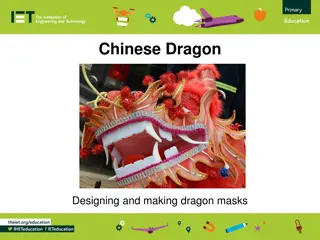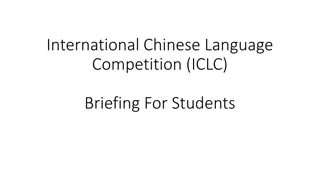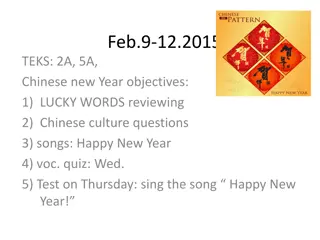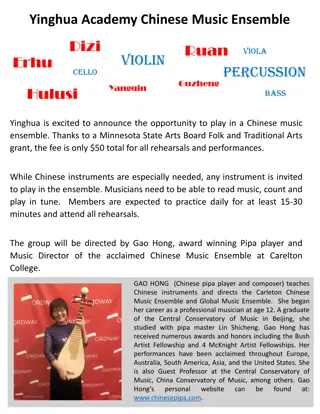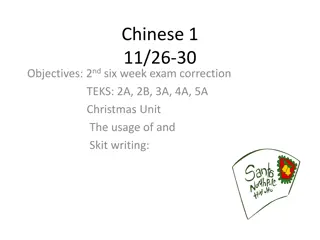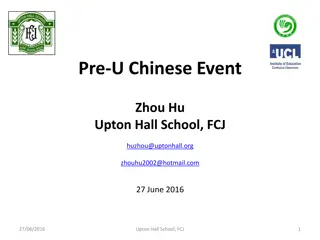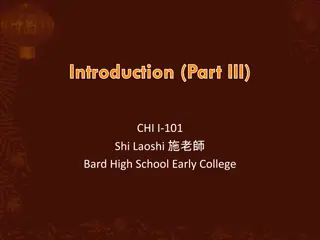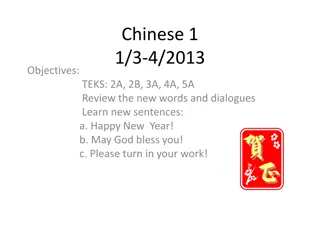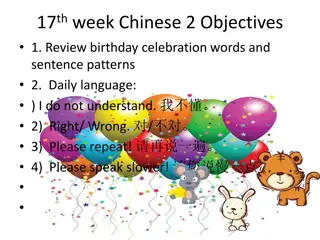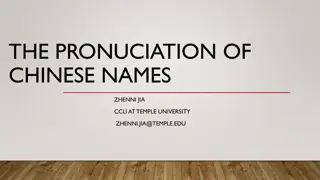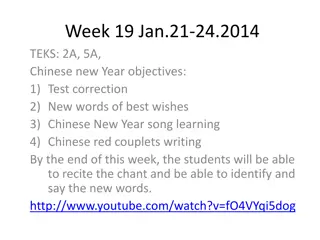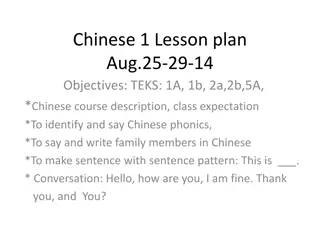Tradition and Innovation in Chinese Language Learning
Continuous innovation is crucial in Chinese language teaching while preserving the value of traditional methods. Strategies like memorization help students internalize language effectively, leading to improved communicative competence. Utilizing model conversations and drills can enhance vocabulary, grammar, and fluency. Balancing tradition and innovation is key to achieving optimal Chinese language proficiency.
Download Presentation

Please find below an Image/Link to download the presentation.
The content on the website is provided AS IS for your information and personal use only. It may not be sold, licensed, or shared on other websites without obtaining consent from the author.If you encounter any issues during the download, it is possible that the publisher has removed the file from their server.
You are allowed to download the files provided on this website for personal or commercial use, subject to the condition that they are used lawfully. All files are the property of their respective owners.
The content on the website is provided AS IS for your information and personal use only. It may not be sold, licensed, or shared on other websites without obtaining consent from the author.
E N D
Presentation Transcript
Tradition and Innovation in Chinese Language Learning and Teaching Cornelius C. Kubler Dept. of Asian Studies Williams College
Introduction Continuous innovation is essential. There will always be more effective and efficient ways to attain our goals of training learners with the highest possible Chinese language proficiency. Some best practices from the past continue to have value. Certain improvements to them may be able to increase their effectiveness. Small changes or tweaks are still innovation. Don t throw the baby out with the bath water!
The Importance of Memorization A traditional Chinese learning strategy Memorization helps students internalize language so they can draw on it later in their own creative performance of Chinese. Memorize model conversations that involve typical communica- tive situations for Americans in China and that incorporate high- frequency linguistic functions, vocabulary, grammar, and culture. Working with audio and video recordings, learners memorize one 8 to 14-line model conversation before class each day. They perform it in class the next day.
To a significant extent, the learner has mastered the lesson to the degree that he or she has internalized the basic conversation. When students perform, not only accurate pronunciation, correct grammar, and fluency are important, but also body language. Students receive a daily grade based on their performance.
The performance of the model conversations by all the students should not take up more than 10-15 minutes of class time. Learners sometimes at first question the necessity of memorization or claim they can t memorize, but with explanation and coaching, this is not a problem. Certainly, memorization is only the first step leading to our ultimate goal of communicative competence, but it s a very important first step.
American: Chinese: American: Chinese: American: Chinese: American: Chinese: American:
The Value and Importance of Drills Drills are essential, but must be done appropriately. Drills can help learners of the more difficult languages internalize the grammatical structures of the language they are studying. Drills can also help learners become more familiar with vocabulary, gain fluency, and increase their confidence in speaking. Most drills should be done OUT OF CLASS by students in self- study mode working with audio recordings and software. The value of drills as enabling mechanisms to help our students attain the ultimate goal of communicative competency should not be underestimated.
Drills: Example 1 Instructions: In answering the question, comment that you are, in each case, three years older than your interlocutor. 1. W j nni n sh li su . N ne? > W j nni nsh ji su . 2. W j nni n rshiy su . N ne? > W j nni n rshis su . 3. W j nni ns nshib su . N ne? > W j nni ns shiy su .
Drills: Example 2 Instructions: Comment that, in each case, you have one more student in your class than the speaker does. 1. W menb nshangy uji ge t ngxu . > W menb nshangy u sh ge t ngxu . 2. W men b nshang y u li ngge t ngxu . > W men b nshang y u s n ge t ngxu . 3. W menb nshangy u li ge t ngxu . > W menb nshangy u q ge t ngxu .
Drills: Example 3 Convert the 24-hour clock times, as commonly used in mainland China and Taiwan, to 12-hour clock times. Add xi w or w nshangas appropriate. Xi y t ng d o Ti nj nde hu ch sh s ndi n rshif n k i. > Xi y t ng d o Ti nj nde hu ch xi w y di n rshif nk i. Xi y t ng d o B ij ngde hu ch rshidi n sh f n k i. > Xi y t ng d o B ij ngde hu ch w nshangb di n sh f n k i. Xi y t ng d o X nji p de hu ch sh w di n w shif nk i. > Xi y t ng d o X nji p de hu ch xi w s ndi nw shif nk i.
ACT and FACT A division between ACT and FACT makes sense for adult learners. ACT = communicative practice, language performance, and language use (all in Chinese, no English) FACT = analysis and explanation about grammar, pronunciation, society, culture, language learning strategies, etc. (mostly in English at the beginning level, with lots of Chinese examples; at the intermediate and advanced levels, FACT can increasingly be done in Chinese)
What do you do in an ACT class? No English by instructor or students, all in Chinese! Should be as small as possible (4-8 students ideal, up to 12 feasible) Performance of Basic Conversation by students with corrections by instructor and repair by students Some drilling (but most drills should be done out of class) Many communicative activities (question and answer, directed dialog, role plays, discussion First a few Teacher-Student (T-S) interactions, then many carefully monitored Student-Student (S-S) interactions
What about conducting small-group activities in ACT class? If the ACT class is already small (10 students or fewer), then usually it is not necessary to divide up further. If there are 15 or 20 or more students in the class, then consider occasional small-group activities. Advantages of Small-Group Activities: Students have more chance to talk. What happens is student-centered, not teacher-centered. Because the number of people is fewer, there is less pressure.
Disadvantages of Small-Group Activities: 1. There is usually no teacher available to offer guidance and correction. 2. Important linguistic content and situations may end up not being practiced 3. Small-group activities easily get off track (may even end up in English!). If you do decide to conduct small-group activities, then be sure to: 1. Make ground rules clear. 2. Absolutely no English! 3. Assign a specific task. 4. Give a time limit (5, 8, 10 minutes). 5. Instructor goes from group to group modeling, correcting, and mentoring.
What do you do in a FACT class? 1. A FACT class can be (much) larger than an ACT class, so class size for a FACT class matters much less than for an ACT class 2. In a FACT class, both the students mother tongue (English) and the target language (Chinese) may be spoken 3. Give many EXAMPLES in the target language 4. Make general comments on how students are doing and how the course is going 5. Comments on common mistakes students are making 6. Presentation of new material on pronunciation ( the geography of the mouth : comparison of target language and English and possibly other languages)
7. Presentation of grammar, including contrast with English (e.g., *Wo chifan zai shitang) 8. Comments on new vocabulary (zuijin, etc.) 9. Comments on Chinese culture and society 10. Comments on gestures and body language 11. Comments on language learning strategies (encourage students to share useful strategies they have developed) 12. Translation into English and explication of difficult parts of the readings 13. Explain how written language differs from spoken language 14. Give students a chance to ask QUESTIONS (since they can t do this in ACT class unless they ask in Chinese)
15. After you have explained a grammar point, test students mastery by calling on students to translate carefully prepared English sentences into Chinese 16. Translation drills can be useful: How do you say 1 pen? 2 teachers? 3 books? etc. 17. Testing: take advantage of the fact you have a large group of students (several sections combined): testing of listening, reading, and writing can all be effectively be done as a large group 18. Discuss administrative matters, housekeeping issues
How to Implement ACT/FACT 1. While both ACT and FACT are important, ACT is ultimately much MORE important 2. Periodic FACT classes are especially important in beginning-level intensive programs, where a daily schedule comprising 1 hour of FACT and 3 to 5 hours of ACT is often appropriate 3. In non-intensive programs (i.e., 1 hour a day, 5 hours per week), there are various options for bringing FACT to the students 4. There could be 4 hours per week of ACT and 1 hour of FACT 5. Or you could have ACT on MWF, and hour of ACT followed by hour of FACT on T/Th 6. Or you could do ACT for the first 30-40 minutes of each class and save the last 10-20 minutes of each class for FACT
Other Ways of Handling FACT 1. Questions by students after class is over 2. Questions by students during office hours or by appointment 3. Required periodic 20-30 minute individual meetings with the instructor to discuss individual student s progress, give students a chance to ask questions, and provide additional practice as needed 4. Optional late afternoon, evening, or weekend review classes 5. Communication by email 6. The Flipped Classroom approach: an old (not a new) concept
The Flipped Classroom 1. Students prepare everything BEFORE class so that class can be used for ACT-type activities (performance, practice in using the language) 2. Put INFORMATION about pronunciation, grammar, society, culture, etc. in the textbook or in a hand-out or online, give students a daily schedule with detailed instructions on what to prepare before each class, and have students study and prepare this material in advance 3. Most students can read, study, and understand FACT-type content by themselves (but they cannot do ACT by themselves) 4. If they still have questions, they can come to instructor s office
Coordinating In-Class Learning With Out-of-Class Learning 1. Learning Chinese consists of different learning activities, some best done in class with an instructor and others learners can do on their own. 2. Learning activities involved for speaking/listening training might include: reading grammar and culture notes, listening to and drilling with audio/video/software, and engaging in various communicative activities 3. Learning activities for reading/writing might include studying the structure of characters, writing characters, prereading the lesson, reading out loud, asking questions about the reading, discussion of the reading, etc. 4. Curriculum designers and instructors should give careful thought to which learning activities must be done in class with an instructor and, on the other hand, which learning activities students can do on their own outside of class.
A More Flexible Approach to Classes 1. Traditionally, a class meets with the same group of students for a set number of days per week. 2. A smarter approach might be to match the size of the class to the particular learning activity, so there might be 1 class per week in a large group of 30 students, 2 classes in medium-sized groups of 8 or 10 students, plus a weekly 20-minute tutorial. 3. FACT, reading, and listening comprehension could be done in a large group, but conversation in the medium-sized group and in the tutorial 4. In addition, of course, there would be a fairly large number of hours each week of out-of-class learning activities by learners using print media, audio, interactive computer software, etc.
Promises and Perils of Educational Technology 1. Newer technologies such as video and satellite reception allow us to provide learners with almost unlimited access to cultural materials from the target language countries 2. Educational technology can appeal to different learning styles 3. Educational technology facilitates our goal of student-centered instruction by putting the learners at the center of the enterprise. 4. Educational technology enables us to make more efficient use of limited and expensive instructor time 5. We can move certain language learning activities, such as drill, out of the classroom, to be done by students in self-study mode on computer in the language learning laboratory or even in their own dormitory room
6. Moving learning activities like drill, that students can do on their own, out of the classroom frees up valuable classroom time for those kinds of interactive learning activities such as conversation practice, discussion, debate, or speech-making that require a live instructor. 7. It s important to design & implement a pedagogically valid curriculum. 8. In developing multimedia materials, wemust always keep our pedagogical goals foremost in mind and realize that technology is only the medium; instructional content and teaching methods are ultimately more important than technology, and the majority of resources and time should be devoted to them.
9. Once the pedagogical goals have been set, one may consider how technology may facilitate attaining those goals; but it should always be the pedagogical goals that drive the technology, and not the other way around.


